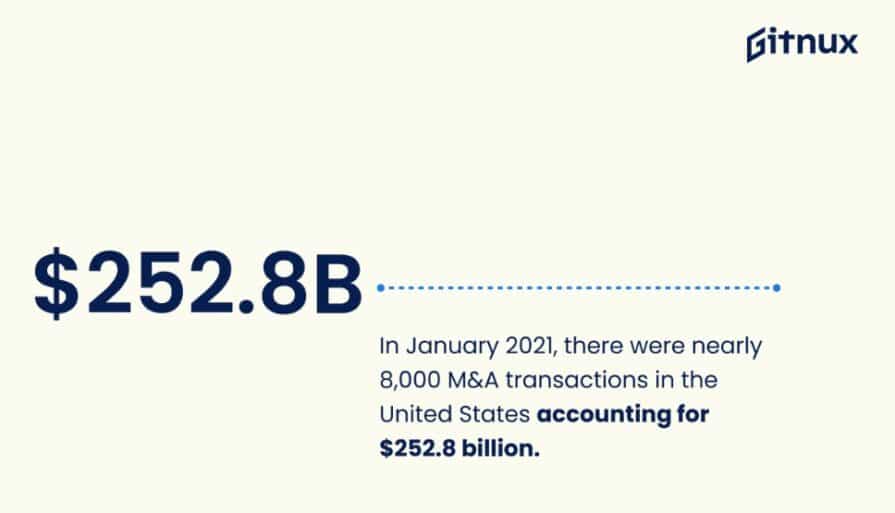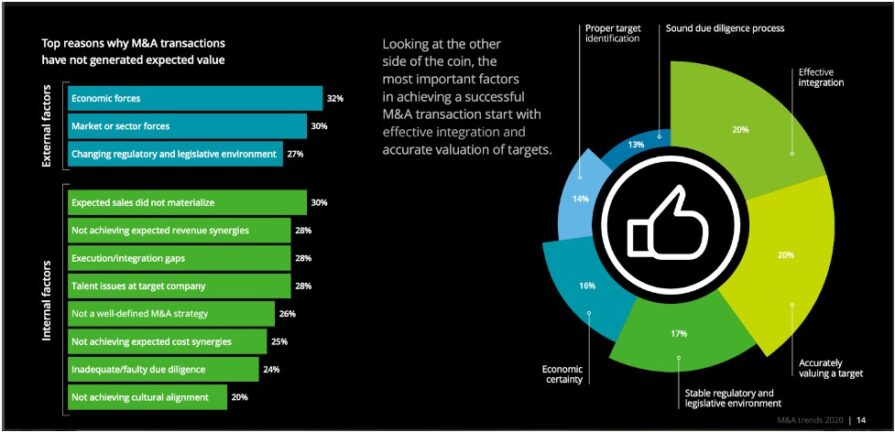So, here’s the thing. Mergers and acquisitions often fail. We’re not saying this to scare you. It’s just a stark reality in the business world, and understanding why they often fall short is crucial.
Now, that’s not to say that mergers and acquisitions can’t be transformative opportunities because they really can! According to Deloitte, a good strategy is the most important factor in a deal’s success. Without the right strategy, you risk becoming a mere statistic in the many failed corporate ventures. For all you PR pros out there, you know more than anyone what a nightmare that can be for your business’ reputation.
In this guide, we’re going to give you quick and informative tips on how to create a winning mergers and acquisitions (M&A) communications plan that’ll make your customers and employees trust, respect, and value you.

Sourced from Gitnux
Understanding M&A communications
In 2022, around 50,000 M&A deals were completed worldwide. Each company had to do some M&A communication, which is essentially the game plan for sharing information about a merger or acquisition with everyone involved, with a keen focus on your employees (who are likely going to be the people who are most affected) and also your customers.
This means you won’t be hitting them with a last-minute email update once the decision is final. No, you’ll be sending regular messages, ranging from the initial announcement to updates on how the whole integration is unfolding.
Why does good M&A communication matter?
You now know what it is, but why should you care? Here are our top reasons why good M&A communication is vital to a smooth transition.

Image sourced from Deloitte
-
Easing worries
When a merger or acquisition is happening, it’s natural for your team to feel a bit uneasy. Job security, leadership changes, workforce scheduling changes, and shifts in roles can all stir up so many concerns. Clear and honest communication can tackle the most common questions and ease the concerns everyone’s likely grappling with. By keeping lines open, you can allow employees to focus on the present instead of getting caught up in “what if” scenarios.
-
Keeping the team intact
In the first year of a company’s acquisition, 33 percent of the acquired employees waved goodbye to their posts, according to Daniel Kim’s paper. The thing is, you’re only as good as your employees, and losing a third of your newly acquired talent is no joke. This is where good communication steps in. It helps to make employees feel heard, valued, and excited about the future.
-
Building trust
External M&A communication for PR
Trust directly impacts the employee experience. The stats tell us that trust isn’t just a nice-to-have but an imperative. So, during mergers and acquisitions, fostering trust through open communication is a must-do for creating a workplace where everyone feels connected, supported, and ready to take on whatever comes their way.
Your external communications are just as crucial as your internal communications. Without it, you could risk alienating your customers and impacting your reputation. Check out our complete guide on optimizing PR during an M&A for more on this!
How to create an M&A communications plan for employees and customers alike
Now that you know the benefits, let’s get to work. Here are our top tips for creating an effective communication plan for both your team and your customers.
Step 1: Assemble a team
The first thing you’re going to want to do is get a communications team together. Forming a robust M&A team should include your brilliant experts from HR, legal, PR, senior management, and IT. This collaborative powerhouse will play an extremely important role in crafting and executing the M&A communications plan for both your internal stakeholders and valued customers.
Step 2: Identify the key audiences

Every employee and customer matters. However, there are usually sub-groups that need a bit of personalized attention. So, gather your cross-functional team and start creating some personas for these groups. Outline their world. How they’ll be affected, what they’re thinking, how they prefer to receive information, and what’s keeping them up at night. It’s all about understanding each group and tailoring your communication accordingly.
Step 3: Develop a clear message
Now, let’s focus on the message we’re putting out there. It’s absolutely crucial to keep this clear, whether you’re jotting down a few punchy statements or laying out a detailed story. You need also to make sure that this message is given the green light from everyone on the M&A. Then, take that message and put it to the test using the audience personas. Does it speak their language? Does it cover why you’re going through this merger or acquisition?
Step 4: Pick the right ways to talk
Choose ways to communicate that fit each group. This could be via a mix of emails, updates on the company’s internal network, videos from our leaders, or even face-to-face meetings. Just think of it like choosing the right tool for the job. For some, an email might be perfect, while others might prefer seeing our leaders on video.
Step 5: Choose the right timing

Timing is everything. Plan meticulously to avoid rumors and leaks. Brief key stakeholders, including managers and department heads, well in advance. Establish a “Day 1” timeline for a thoughtful cascade of communications, with employees getting the scoop as early as legal and regulatory requirements allow.
Step 6: Develop resources
Equip your employees and customers with resources to navigate the changes. In the same way that you’d share a ‘what is CCaaS’ guide with your agents if you move your infrastructure to the cloud, you’re going to want to give stakeholders the complete lowdown on how the M&A will affect them. Ensure that your leaders are well-prepared by providing toolkits with key messages, slides for team meetings, FAQs, and tips for handling questions.
Step 7: Establish ongoing communication
M&A communication is not a one-time thing. Keep the dialogue alive with regular updates and check-ins, especially with direct managers. This ensures everyone stays in the loop about integration progress and any changes affecting them. For your customers, there should be a customer support team—call center solutions can be useful here—made available to them to reach you when they have questions.
Final thoughts
So there you have it—our top tips for creating an M&A communications plan! Your communication needs to be ongoing to keep everyone informed and maintain trust. At the end of the day, nobody wants upset customers or employees. You want this new move to be an exciting thing, not something people are dreading or running away from. Good luck!








